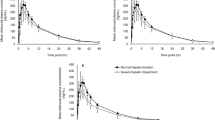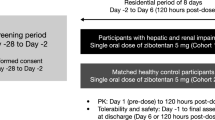Abstract
Objective
To evaluate the effect of moderate liver impairment on the pharmacokinetics of eslicarbazepine acetate (BIA 2-093, ESL), a novel voltage-gated sodium channel blocker currently in clinical development.
Methods
The pharmacokinetics of ESL following an administration regimen of 800 mg once-daily for 8 days was characterized in patients with moderate liver impairment (n = 8) and in subjects with normal liver function (n = 8, control group).
Results
Eslicarbazepine acetate was rapidly and extensively metabolized by first-pass metabolism to its main active metabolite, eslicarbazepine (S-licarbazepine). There were more subjects with measurable plasma concentrations of the parent drug (ESL) in the hepatic impairment group than in the control group, suggesting that first-pass metabolism was slightly decreased by liver impairment. However, ESL plasma concentrations remained very low, representing only about 0.01% of total systemic exposure. No differences in the pharmacokinetics of eslicarbazepine or its metabolites were found between the hepatic impairment and control groups. Urinary excretion of eslicarbazepine and its glucuronide form was similar in the liver impaired and control subjects. The sum of drug moieties recovered in the urine corresponded to 91% of the administered dose in the control group and to 84% of the administered dose in the liver impairment group.
Conclusion
The pharmacokinetics of ESL was not affected by moderate hepatic impairment. Therefore, patients with mild to moderate liver impairment treated with ESL do not require dosage adjustment.



Similar content being viewed by others
References
Benes J, Parada A, Figueiredo AA, Alves PC, Freitas AP, Learmonth DA, Cunha RA, Garrett J, Soares-da-Silva P (1999) Anticonvulsant and sodium channel-blocking properties of novel 10,11-dihydro-5H-dibenz[b,f]azepine-5-carboxamide derivatives. J Med Chem 42:2582–2587
Almeida L, Falcão A, Maia J, Mazur D, Gellert M, Soares-da-Silva P (2005) Single-dose and steady-state pharmacokinetics of eslicarbazepine acetate (BIA 2-093) in healthy elderly and young subjects. J Clin Pharmacol 45:1062–1066
Almeida L, Soares-da-Silva P (2003) Safety, tolerability and pharmacokinetic profile of BIA 2-093, a novel putative antiepileptic agent, during first administration to humans. Drugs R D 4:269–284
Almeida L, Soares-da-Silva P (2004) Safety, tolerability, and pharmacokinetic profile of BIA 2-093, a novel putative antiepileptic, in a rising multiple-dose study in young healthy humans. J Clin Pharmacol 44:906–918
Vaz-da-Silva M, Nunes T, Soares E, Rocha JF, Tavares S, Falcão A, Almeida L, Soares-da-Silva P (2005) Eslicarbazepine acetate pharmacokinetics after single and repeated doses in healthy subjects. Epilepsia 46:191
Almeida L, Soares-da-Silva P (2007) Eslicarbazepine acetate (BIA 2-093) Neurotherapeutics 4:88–96
Falcao A, Maia J, Almeida L, Mazur D, Gellert M, Soares-da-Silva P (2007) Effect of gender on the pharmacokinetics of eslicarbazepine acetate (BIA 2-093), a new voltage-gated sodium channel blocker. Biopharm Drug Dispos 28:249–256
Elger C, Bialer M, Cramer JA, Maia J, Almeida L, Soares-da-Silva P (2007) Eslicarbazepine acetate: a double-blind, add-on, placebo-controlled exploratory trial in adult patients with partial-onset seizures. Epilepsia 48:497–504
EMEA/CHMP Guideline on the Evaluation of the Pharmacokinetics of Medicinal Products in Patients with Impaired Hepatic Function (2005). Committee for Medicinal Products for Human Use, European Medicines Agency, London
FDA/CDER Guidance for Industry Pharmacokinetics in Patients with Impaired Hepatic Function – Study Design, Data Analysis, and Impact on Dosing and Labeling (2003). Food and Drug Administration, U.S. Department of Health and Human Services, Centre for Drug Evaluation and Research, Washington D.C.
Author information
Authors and Affiliations
Corresponding author
Rights and permissions
About this article
Cite this article
Almeida, L., Potgieter, J.H., Maia, J. et al. Pharmacokinetics of eslicarbazepine acetate in patients with moderate hepatic impairment. Eur J Clin Pharmacol 64, 267–273 (2008). https://doi.org/10.1007/s00228-007-0414-1
Received:
Accepted:
Published:
Issue Date:
DOI: https://doi.org/10.1007/s00228-007-0414-1




